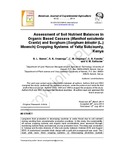| dc.contributor.author | Namoi, N L | |
| dc.contributor.author | Onwonga, R N | |
| dc.contributor.author | Onyango, C M | |
| dc.contributor.author | Karuku, G N | |
| dc.contributor.author | Kathumo, V M | |
| dc.date.accessioned | 2014-07-14T06:31:57Z | |
| dc.date.available | 2014-07-14T06:31:57Z | |
| dc.date.issued | 2014-07-12 | |
| dc.identifier.citation | Namoi N. L., Onwonga, R. N.,Onyango, C. M., . Karuku, G N., Kathumo,V M. (2014). Assessment of Soil Nutrient Balances in Organic Based Cassava (Manihot esculenta Crantz) and Sorghum (Sorghum bicolor (L.) Moench) Cropping Systems of Yatta Subcounty, Kenya. American Journal of Experimental Agriculture 4(12), PP. 1559-1578 | en_US |
| dc.identifier.uri | http://www.sciencedomain.org/abstract.php? | |
| dc.identifier.uri | http://hdl.handle.net/11295/72900 | |
| dc.description.abstract | Long-term food production in developing countries is under threat due to soil nutrient mining resulting from unsustainable production practices. In this study, the sustainability of various cropping systems and organic input combinations were assessed through monitoring nutrient flows and balances at crop production level. The study was conducted in Katangi and Ikombe divisions of Kitui sub-county between October 2010 and August 2012. A randomised complete block design with a split plot arrangement was used. The main plots were three cropping systems: (i) Intercropping (Dolichos [Lablab purpureus]/Cassava, Dolichos/Sorghum, Pigeon pea [Cajanus cajan (L.) Millsp.]/Sorghum, Pigeon pea/Cassava); (ii) Rotation (Dolichos-Cassava, Dolichos-Sorghum, Pigeon pea-Cassava, Pigeon pea-Sorghum); (iii) Monocrop (pure cassava and sorghum). The split plots were; farm yard manure (FYM), compost and control. All crops had above ground biomass incorporated after harvest in the same plot they were harvested from. Nutrient flows; nitrogen (N), phosphorus (P) and potassium (K), were monitored for four seasons; short rain season (SRS) of 2010, long rain season (LRS) of 2011, SRS of 2011 and LRS of 2012 using NUTMON toolbox. There were no significant differences in nutrient balances between the four seasons except in sorghum based cropping systems where N and P balances were significantly lower in the second year. Losses across the seasons occurred mainly through harvested products in both sorghum and cassava cropping systems while addition mainly occurred through biological N fixation and incorporation of crop residue. Negative NPK balances were found in cassava than sorghum-based cropping systems regardless of legumes used in both sites. Dolichos rotation with sorghum and compost applied resulted in positive N balances. Dolichos-cassava rotation with compost also had reduced N losses compared to when pigeon pea was used. P losses were less negative under pigeon pea-sorghum and pigeon pea-cassava rotation with FYM applied. Pigeon pea rotation with sorghum and FYM applied resulted in reduced K losses while with cassava the same cropping system was superior but with application of compost. The choice of legume and organic input for use would depend on environment farmer operates in. In N, P and K limited environments; dolichos rotation with compost application, pigeon pea rotation plus FYM and, pigeon pea-sorghum rotation plus FYM and pigeon pea-cassava rotation with compost applied would, respectively, be recommended as farming practices. - See more at: http://www.sciencedomain.org/abstract.php?iid=586&id=2&aid=5303#.U8N1uECKE3x | en_US |
| dc.language.iso | en | en_US |
| dc.publisher | University of Nairobi | en_US |
| dc.title | Assessment of Soil Nutrient Balances in Organic Based Cassava (Manihot esculenta Crantz) and Sorghum (Sorghum bicolor (L.) Moench) Cropping Systems of Yatta Subcounty, Kenya . | en_US |
| dc.type | Article | en_US |
| dc.type.material | en_US | en_US |

